The Culpeper Flags, Navy Jack and Ship
Compiled and edited by Warren Culpepper

Table of Contents

Join or Die
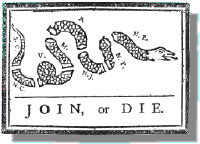 The rattlesnake, found in the American
Colonies and nowhere else in the world, appears to have been a favorite emblem of
the Americans even before the Revolution. In 1751 Benjamin
Franklin's Pennsylvania Gazette carried a bitter article protesting the British
practice of sending convicts to America. The author suggested that the colonists return
the favor by shipping "a cargo of rattlesnakes, which could be distributed in St.
James Park, Spring Garden, and other places of pleasure, and particularly in the
noblemen's gardens." Three years later the same paper printed the picture (as seen
above) of a snake as a commentary on the Albany Congress. To remind the delegates of the
danger of disunity, the serpent was shown cut to pieces. Each segment is marked with the
name of a colony, and the motto "Join or Die" below. Other newspapers took up
the snake theme. The rattlesnake, found in the American
Colonies and nowhere else in the world, appears to have been a favorite emblem of
the Americans even before the Revolution. In 1751 Benjamin
Franklin's Pennsylvania Gazette carried a bitter article protesting the British
practice of sending convicts to America. The author suggested that the colonists return
the favor by shipping "a cargo of rattlesnakes, which could be distributed in St.
James Park, Spring Garden, and other places of pleasure, and particularly in the
noblemen's gardens." Three years later the same paper printed the picture (as seen
above) of a snake as a commentary on the Albany Congress. To remind the delegates of the
danger of disunity, the serpent was shown cut to pieces. Each segment is marked with the
name of a colony, and the motto "Join or Die" below. Other newspapers took up
the snake theme.
By 1774 the segments of the snake had grown together, and the motto had been changed to
read:
United Now Alive and Free
Firm on this Basis Liberty Shall Stand
And Thus Supported Ever Bless Our Land
Till Time Becomes Eternity

A Flag of Conviction: "Don't Tread On
Me"
By Matthew Robinson
14 Jun 2000
CNSNews.com and the Pittsburgh
Tribune-Review.
Christopher Gadsden's face and name may not be immortalized on any
bill or coin, but this firebrand designed a symbol which, even through
the swirling mists of time, is a reminder of the birth of the nation and
the spirit that carried it to freedom.
June 14 is Flag Day. On that day, of course, we remember the Stars
and Stripes and the men who fought under that banner for freedom.
Gadsden gave us another great flag, one that flew prominently during the American
Revolution, under which many men fought and died. Gadsden's was the
blazing yellow banner that sports the ominous coiled snake and
revolutionary warning, "Don't Tread on Me."
Today we don't take the time as we once did to remember those iron
men who fought the Revolution. And, worse, we seem to have forgotten the
principles, energy, and sacrifice they poured into defending freedom and
the rule of law.
South Carolina's Christopher Gadsden is as much a symbol of the
spirit of the American Revolution as his flag. When Parliament passed
the Stamp Act in 1765, Gadsden helped rally opposition to that
oppressive law. He argued that taxation without representation in
Parliament violated the most basic laws of the English constitution and
the natural rights of citizens.
The Stamp Act, like many of the attempts to control the colonies,
would set an unlawful precedent. The taxes on tea, trade and even paper
were modest. The real problem, the revolutionaries understood, is that the Stamp
Act laid the groundwork for the unlimited and unrepresentative expansion
of government. It was the thin edge of the wedge.
As John Dickinson wrote, "If Parliament succeeds in this
attempt, other statutes will impose other duties... and thus Parliament
will levy upon us such sums of money as they choose to take without any
other limitation than their pleasure."
Gadsden was a man of principle who understood that government, unless
held in check, grows slowly and inexorably. And a government that has no
limits, no constitutionally drawn boundaries, soon becomes the master
and the citizens become heavily-taxed workers little more than slaves.
Without representation--the ability to fight for their interests--the
colonies would be subject to the whim and will of politicians ever in
search of more revenue and swag to grant the "court locusts"
who buzz around institutions of power expecting a handout.
When the Stamp Act was passed the British envoy who was set to
enforce the new law tried to land in Charleston. But Gadsden led the
Sons of Liberty against the tax-collecting functionary. The patriots
would not let his ship anchor to enforce the illegal act. Then, the
captain of the British ship turned back through the mouth of the
Charleston harbor to anchor at Fort Johnson.
The Sons of Liberty, no doubt alcohol-fueled and intoxicated with
raucous songs of their victory, heard of this and decided to show
Parliament just how much they hated oppressive taxes. They traveled to
the fort, took it over, and aimed the British guns at the Stamp Act
collector's ship. Outmatched and obviously outgunned, the captain set to
sea never to return. Gadsden and his men then went home. Through legal channels, the
patriots continued their resistance to the Stamp Act and eventually had
it overturned.
Eight years later, America was in full rebellion against British
rule, which had become more capricious and still threatened unjust and
burdensome taxation. It was then that Gadsden became a colonel in the
Revolutionary Army and presented his unique ensign as the flag of the
Cause.
The coiled snake might seem a strange symbol today. But it was and is
effective. No American who ever sees it forgets -- and that's just the
kind of message the revolutionaries wanted to send.
For those early Americans, the rattlesnake had special significance.
Like liberty, the rattler was found only in America. But that wasn't
all. That wily serpent was usually just a harmless, humble creature. But
aroused, angered, and prodded, first it warned with violent rattle then
it struck with a deadly bite. Gadsden emphasized this by printing the
legend "Don't Tread On Me" on his flag.
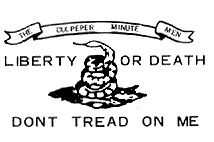 The words swept the nation. It became the banner of minutemen
militias. The Culpeper
Minutemen chose the coiled snake ready to strike
and the words from Gadsden's flag, but then raised another defiant fist
at England by adding the words: "Liberty or Death." The words swept the nation. It became the banner of minutemen
militias. The Culpeper
Minutemen chose the coiled snake ready to strike
and the words from Gadsden's flag, but then raised another defiant fist
at England by adding the words: "Liberty or Death."
At sea, the first flag of the Continental Navy carried Gadsden's
warning, this time with a sea snake slithering across the 13
red-and-white stripes.
Early Americans saw the tremendous opportunities of a land born of
liberty where men were free to innovate, invent and explore. They could
reap the rewards of freedom without government meddling and were safe
because they answered to God, family and their local communities.
Most of all, those early Americans understood that liberty is
fragile. To give any distant body of elites the power to tax and spend
to stay in power promises corruption and a Leviathan government more
interested in concentrating power for itself than in protecting the
rights of its citizens.
Flag Day may be about the Stars and Stripes, a banner that symbolizes
freedom and justice to Americans and the world. But Gadsden and his flag
are a still a symbol that liberty needs friends who can fight for the
rule of law and principle for the good of the generations to come.
Matthew Robinson is the 1999 Phillips Foundation Journalism Fellow
and an adjunct fellow of the Claremont Institute.

The Culpeper Don't Tread
on Me Flag
The Culpeper Don't Tread On Me Flag reportedly was first
used as the banner for a group of about one
hundred minutemen in Culpeper County,
VA who formed part of Colonel Patrick Henry's First Virginia Regiment of
1775. In October-November 1775, three hundred such minutemen, led by Colonel Stevens,
assembled at Culpeper Court House and marched for Williamsburg. Their unusual dress
alarmed the people as they marched through the country. The words "Liberty or
Death" were in large white letters on the breast of their hunting shirts. They had
bucks' tails in their hats and in their belts, tomahawks and scalping knives.
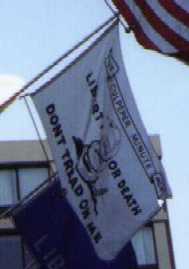 The
rattlesnake device occurs on several Revolutionary War flags. The rattlesnake's eye,
supposedly brighter than any other creature's and with no eyelids, is the symbol of
vigilance. It is said that the snake never begins an attack, but once aroused it never
surrenders. The snake was also portrayed with 13 rattles, symbolic of the 13 American
colonies. The
rattlesnake device occurs on several Revolutionary War flags. The rattlesnake's eye,
supposedly brighter than any other creature's and with no eyelids, is the symbol of
vigilance. It is said that the snake never begins an attack, but once aroused it never
surrenders. The snake was also portrayed with 13 rattles, symbolic of the 13 American
colonies.
The photo at the above right (taken by Royce Culpepper) shows the Culpeper
Minutemen flag flying in 1993 at the Holiday
Inn in Philadelphia, near Christ Church where Benjamin Franklin is buried. It features a
rattlesnake on a solid background above the warning, "Don't Tread On Me".

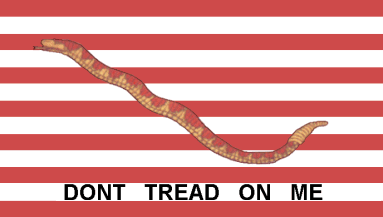 The
Culpepper Ensign (often referred to in error as a "Navy Jack") The
Culpepper Ensign (often referred to in error as a "Navy Jack")
Subsequently, there was a Naval rendition of the Culpeper Minutemen
Flag. This was one of the first flags to show 13 stripes, one for each American colony,
along with the rattlesnake (although some sources say that this was a poisonous sea
snake). It features the snake above the warning, Don't Tread On Me. As
previously mentioned, the rattle snake had become a traditional symbol of the American
Colonies and the Colonial Navy apparently adopted the sea going version of this and the
Culpeper name stuck with it.
 This flag is believed to have flown aboard the
Continental Fleet's flagship Alfred, in January, 1776. This flag or one of it's variations
was used by American ships throughout the Revolution. This flag is believed to have flown aboard the
Continental Fleet's flagship Alfred, in January, 1776. This flag or one of it's variations
was used by American ships throughout the Revolution.

14 Mar 1999
To: Culpepper Connections!
Re: The Culpeper Ensign or National Flag
...[What almost everyone has labeled] the Culpeper Navy Jack is actually an Ensign,
or National Flag. I have written the book Early American Naval Flags & Signals,
soon-to-be-published. The comments from flag experts (vexilloigists) about the research I
have done is that it is based in primary documentation and that it is definitive.
A Navy Jack in the Age of Sail was flown from the fore masthead. The Culpeper Flag
was flown from the gaff peak on all ships in [the] squadron, the traditional and symbolic
place of honor for the National Ensign -- only. This correction of
JACK-to-ENSIGN is in my book.
A National Flag was used on land (predominate early American flag terminology) and a
National Ensign was used at sea -- so it is properly called the Culpeper Ensign.
...Your heritage is about an ENSIGN -- not merely a JACK -- and is an heritage of one
of our nation's first national emblems at sea shortly after the start of the War of the
Revolution.
The Musee de la Marine, Paris, France, has an anonymous engraving attributed to
about 1779 showing a striped rattlesnake flag flying from a jackstaff on the bowsprit of
the Continental Navy Frigate Alliance (36). Dr. Whitney Smith of the Flag Research Center,
Winchester, Massachusetts, (781) 729-9410 can direct you to the ensign information (that
the same flag was flown from the gaff peak of several ships).
[Also see David B. Martucci's web site on US Flags]
Sincerely,
Ray Morton
raymorton@earthlink.net

Culpeper (PC 1240)
WW-II Submarine Chaser




Call sign: November - Charlie - Papa - Lima

PC-461 Class Submarine Chaser:
Laid down, 15 May 1943 by the Consolidated Shipbuilding Corp., Morris
Heights, NY; Launched, 26 June 1943; Commissioned USS PC-1240, 13 October
1943; Placed out of commission, in reserve, October 1949 at Norfolk, VA;
Named Culpeper, 1 February 1956; Struck from the Naval Register, 1
April 1959 and sold for scrap.
Specifications: Displacement 280 t.(lt) 450 t.(fl); Length
173' 8"; Beam 23'; Draft 10' 10"; Speed; 22k; Complement 65; Armament one
single 3"/50 gun mount, one 40mm gun mount, two 20mm guns, four depth
charge projectors (K-guns), two depth charge tracks, two rocket launchers;
Propulsion two Hooven-Owen-Rentschler R-99DA diesel engines (Serial No.
7051 & 7052), two shafts.
Source: NavSource Online
Origin of Name:
Unknown, but given the 2-p
spelling, it most likely was named for
the Culpeper Minutemen
of the Revolutionary War or for
Culpeper, Virginia.

Where You Can Purchase a Culpepper Flag

Post Script from Publisher
While a number of Culpepers/Culpeppers fought in the American
Revolution, none were in the Culpeper Minutemen and apparently no individual Culpeper or
Culpepper was ever directly connected to these flags.
If you are aware of other information on these flags or on
the hat below, please see Sending
Us Information.

The Culpepper Hat
We don't know the origin of the name, but we can't
help but include on this page the sales copy we found at
Quality Hats for a
classic straw Stetson hat.
| 6366 Culpepper
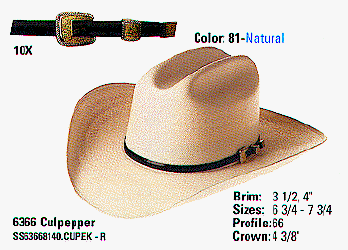 A
beautiful hat by Stetson. A
beautiful hat by Stetson.
$ 89.95
Includes Free
Shipping!
 | Stocked in 4 inch brim. |
|

Last Revised:
02 Jan 2015 |